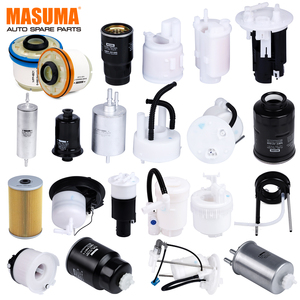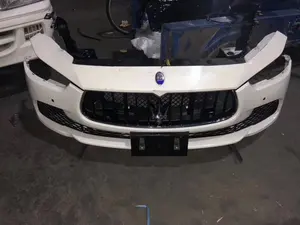(6717 products available)









































































































































































Engine:
The engine is the heart of the vehicle and creates power for the car. There are different types of engines, such as gasoline, diesel, electric, and hybrid engines. Gasoline and diesel engines use fuel to power the car, while electric engines use batteries, and hybrid engines use a mix of gas and electric.
Transmission:
The transmission is what sends power from the engine to the wheels so they can spin. There are also different types of transmissions in cars. Manual transmissions require drivers to change gears themselves. Automatic transmissions do the gear-changing work for the driver.
Wheels and Tires:
The tires are what connect the car to the road. Tires come in different sizes and types for various weather conditions, like summer, winter, or all-season. The wheels are the metal parts that hold the tires in place.
Brakes:
Brakes slow down or stop the car when needed. There are two main types of brakes. Disc brakes use flat metal plates called discs to stop the wheels, while drum brakes use round metal tubs called drums to brake.
Suspension:
The suspension system connects the car body to the wheels and helps maintain contact between them. It is responsible for the vehicle's smooth ride. The suspension has parts like springs, shock absorbers, struts, and arms.
Electrics and Electronics:
Every modern car has a network of cables and batteries that power the lights, dashboard, and other electrical parts. Electronics control many things in the car, like the engine, entertainment system, and safety features. Key electrical components are the battery, alternator, starter motor, fuses, and switches.
Body and Interior:
The car body is the outside part that gives the vehicle its shape and style. It also protects everything inside the car. Interior parts include the seats, seat belts, windows, roof, walls, floor, doors, and center console. The body and interior have features to make driving comfortable and safe.
Fuel System:
The fuel system stores, cleans, and moves fuel from the gas tank to the engine. The main parts of the fuel system are the gas tank, fuel pump, fuel filter, and fuel injectors or carburetor (in older cars). The fuel injectors spray precise amounts of fuel into the engine to create power.
Exhaust System:
The exhaust system takes the used air (exhaust) that the engine makes and moves it out of the car. It also helps quiet the noise from the exhaust. The exhaust has pipes that carry the exhaust, a muffler that reduces the sound, and a catalytic converter that cleans up harmful stuff in the exhaust before it leaves the car.
Air Intake System:
The air intake system brings clean air into the engine to mix with the fuel. A well-working air intake helps the engine run great. The parts include the air filter, air filter housing, and ducting that carry air to the engine.
Steering:
The steering wheel and parts that help drive the car where one wants to go. Steering systems include manual and power steering. Power steering uses electricity or hydraulic pressure to make turning the wheel easier.
Climate Control:
Climate control lets drivers set the temperature inside the car. The system has heating, cooling, and ventilation parts to provide a comfortable ride, no matter the weather outside.
Safety Features:
Every car has features to help keep people safe. Safety systems include things like seat belts, airbags, anti-lock brakes (ABS), electronic stability control (ESC), traction control, and strong car body parts that absorb crashes. Some cars also have active safety systems that warn drivers of dangers.
Regular oil changes
Maintaining the health of the engine oil is critical. Keeping the engine oil fresh and clean helps lubricate and protect vital components from wear and tear. Oil changes also prevent the build-up of harmful sludge that can clog passages over time. Generally, oil changes every 5,000 to 7,500 miles are recommended, although the timing may vary based on driving conditions or the type of oil used. Checking the dipstick periodically between changes is also advisable. Low levels could signal a potential leak or increased consumption that needs investigation.
Checking tire health
Tires provide essential contact with the road, so monitoring their condition is vital for safety and performance. Inspecting tread depth helps ensure adequate traction in all weather conditions. The penny test—placing a penny head-first in the tread—can indicate if replacement is needed when Lincoln's head becomes visible. Uneven wear patterns could point to misalignment or suspension issues requiring prompt attention. Proper inflation per the manufacturer's spec also maximizes fuel efficiency and tire longevity while preventing blowouts from overpressure. The owner's manual provides correct PSI values that should be routinely checked. Under-inflated tires can increase rolling resistance, decreasing gas mileage.
Brake inspection
Brakes, of course, are critical for stopping power and safety. Regular inspections of pads, rotors, and calipers help prevent potentially dangerous brake failure. Pads should be checked for sufficient thickness, as worn ones can damage rotors. The rule of thumb is to replace pads before they wear down to 3mm. Rotors should be smooth, but minor surface rust or scoring is normal. A mechanic can use a brake lathe to resurface slightly damaged rotors. Calipers apply pressure to pads, so dirty, damaged, or unevenly working calipers need prompt attention. Visual inspections, along with occasional hydraulic pressure tests, can identify problems.
Battery maintenance
The car battery provides the electrical power needed to start the vehicle and run accessories. It is vital to ensure clean and tight connections to terminals, as corrosion or loose cables can cause starting issues. A simple periodic cleaning with a mixture of baking soda and water helps prevent build-up. Proper ventilation is also important, as trapped gas can lead to explosion risk.
Monitoring the battery's voltage with a multimeter or taking it to an auto parts store for testing can identify weakening cells that may need replacement. Extreme temperatures, especially heat, are particularly damaging to battery lifespan.
Car Compatibility
When choosing parts for a car, it is important to consider its compatibility. This means ensuring that the part will work well with other parts of the car. For example, if the car has a V6 engine, look for parts that are made for a V6 engine, not a 4-cylinder one. This is because parts are often designed to fit perfectly with different engine types or car models. Using parts that do not match the car can cause problems and reduce performance. The part may physically fit, but it might not connect properly with other components or provide the same level of efficiency.
Quality and Reliability
Quality and reliability are important when choosing car parts. High-quality parts come from trusted brands and are made with care. This means they will probably last a long time and work well. Reliable parts help the car run smoothly without problems. It is also important to choose parts with good quality and reliability.
Budget Considerations
Budget considerations are also important when selecting car parts. It is necessary to decide how much money can be spent before shopping. Quality car parts may have a higher initial cost, but they are often more durable and reliable, which can save money in the long run. While it may be tempting to choose cheaper options, low-quality parts can lead to more frequent repairs or replacements. Therefore, it is essential to find a balance between affordability and quality.
Future Maintenance
When choosing parts for a car, it is also important to think about future maintenance. Some parts need more care than others. It is good to choose parts that are easy to take care of. That way, maintaining the car will be simple and not too costly. For example, brake pads made from materials that wear down evenly on the rotors can make the brakes last longer and require less frequent replacement.
Warranty
When selecting car parts, it is good to choose those with a warranty. A warranty means the company stands behind what it makes. If something goes wrong with the part, the business will fix or replace it for free during the warranty time. This gives extra peace of mind because it shows the part should work well. Different parts have other warranties, so it is good to check how long the warranty is before buying.
Car parts replacements should be done with utmost care to avoid damaging the part being replaced or compromising safety. Here are the general steps to follow when replacing list car parts.
Read the manual
Guides: Car manufacturers provide guides with detailed instructions on how to replace important parts. The guide has information on how to replace the part safely and without causing damage. Read the guide and follow all the instructions.
Get the right tools
Find out the tools needed to replace the part and make sure to have them. Using the right tools makes the work easier and ensures the replacement is done correctly.
Prepare the car
Prepare the car: Depending on the part being replaced, some preparations may be needed. This could include things like lifting the car with a jack, removing tires, or opening the hood. Carry out all the preparations as required.
Remove the old part
Removing the old part is the most difficult and dangerous step when replacing car parts. Make sure to follow all safety precautions and the steps in the manual to remove the old part safely. Be careful not to damage anything else in the car when removing the old part.
Inspect and clean
Once the old part has been removed, inspect the area to make sure nothing has been damaged. Clean the area where the new part will be installed.
Install the new part
Follow the instructions in the manual to install the new part. Make sure it is installed correctly and tightly.
Test
Start the car and test to make sure the new part is working properly.
Q1: Do more car parts make a car better?
A1: A car with more parts is not necessarily better. It all depends on the functionality of those parts. For example, a car with a better engine and quality tires will outperform the others.
Q2: Can a car move without essential car parts?
A2: No, a car cannot move without essential parts like the engine, fuel system, and exhaust system. These parts are necessary for the car to function and operate.
Q3: What are car accessories?
A3: Car accessories are not essential for a car's operation. It can function well without them. For example, a car can run without a stereo system or leather upholstery. However, these add-ons can enhance the driving experience, comfort, and overall enjoyment.